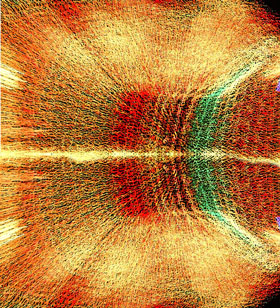 |
| Scientists have discovered a menagerie of particles, and suspect that the universe contains many more — perhaps including particles of dark energy and dark matter. |
Physicists have observed lots of particles in the universe: the protons, neutrons, and electrons that make up atoms; the quarks that make up protons and neutrons; and particles with such exotic names as muons, leptons, and neutrinos. At the same time, they have observed many "fields" that play important roles in the universe: magnetic fields, electric fields, and gravitational fields, among others.
And they are looking for even more. The world’s largest particle accelerator, which is scheduled to begin operations in Europe in 2008, will search for a particle called the Higgs boson, which may be responsible for the "field" that gives mass to some particles but not others. In fact, particles and fields are just different descriptions of the same phenomena. Just as matter and energy are equivalent, as Albert Einstein described in his theories of relativity, particles and fields are equivalent, too.
The search for new particles and fields extends to the search for dark energy and dark matter.
Dark matter fills the universe, and exerts a gravitational pull on the "normal" matter, like stars and planets, around it. Yet it produces no detectable form of energy – no light, heat, radio waves, or anything else. Some physicists believe that dark matter is a form of particle that was produced in the Big Bang but that has not yet been detected.
 |
| Dark energy may consist of an undiscovered energy field that permeates the universe, and that may change over time. |
Others describe a new field that permeates the universe, called quintessence. One key difference from the vacuum energy is that quintessence would vary with time, so it might not show up at all in the early universe, but exert a powerful influence today. There are several hypotheses of quintessence fields, and in each one, each with a different outcome for the future of the universe.
So far, there’s no evidence of dark energy particles or fields. Discovering them would require not only the efforts of astronomers, but new experiments for even more powerful particle accelerators, which are decades away.




0 comments:
Post a Comment
IT'S YOUR TURN...
To respond : Drop in just anything but spam. Please don't drop comments just to add your link here. You can use basic HTML tags.
Important : If you're looking for further clarification, advice or support, please address by comment.